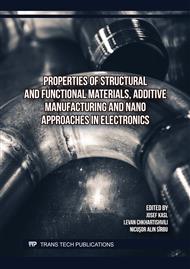[1]
A.K. Geim, K.S. Novoselov, The rise of graphene, Nature Mater. 6 (3) (2007) 183-191.
Google Scholar
[2]
D.C. Marcano, D.V. Kosynkin, J.M. Berlin, A. Sinitskii, Zh. Sun, A. Slesarev, L.B. Alemany, W.Lu, J.M. Tour, Improved synthesis of graphene oxide, ACS Nano, 4 (8) (2010) 4806-4814.
DOI: 10.1021/nn1006368
Google Scholar
[3]
L. Sun, B. Fugetsu, Mass production of graphene oxide from expanded graphite, Mater. Lett. 109 (2013) 207-210.
DOI: 10.1016/j.matlet.2013.07.072
Google Scholar
[4]
X.Hu, Y.Yu, J.Zhou, L. Song, Effect of graphite precursor on oxidation degree, hydrophilicity and microstructure of graphene oxide, Nano Brief Rep. Rev. 9(3) (2014) 1450037 1-8.
DOI: 10.1142/s1793292014500374
Google Scholar
[5]
M.P. Lavin–Lopez, M. Valverde Palomino, L. Sanchez–Silva, A. Romero Izquierdo, Optimization of the synthesis procedures of graphene and graphite oxide, in: P.K. Nayak (Ed.), Recent Advances in Graphene Research, InTech, 2016, Ch. 5, http://dx.doi.org/10.5772/63752, pp.122-133.
DOI: 10.5772/63752
Google Scholar
[6]
A.M. Dimiev, S. Eigler (Eds.), Graphene Oxide: Fundamentals and Applications, Wiley, Chichester, 2016.
Google Scholar
[7]
X. Hu, Y. Yu, J. Zhou, L. Song, Effect of graphite precursor on oxidation degree, hydrophilicity and microstructure of graphene oxide, Nano 9 (3) (2014) 1450037 (1-8).
DOI: 10.1142/s1793292014500374
Google Scholar
[8]
A. Ambrosi, Ch.K. Chua, B. Khezri, Z. Sofer, R.D. Webster, M. Pumera, Chemically reduced graphene contains inherent metallic impurities present in parent natural and synthetic graphite, Proc. Natl. Acad. Sci. USA 109 (32) (2012) 12899-12904.
DOI: 10.1073/pnas.1205388109
Google Scholar
[9]
H. Yang, H. Li, J. Zhai, L. Sun, H. Yu, Simple synthesis of graphene oxide using ultrasonic cleaner from expanded graphite, Ind. Eng. Chem. Res. 53 (46) (2014) 17878-17883.
DOI: 10.1021/ie503586v
Google Scholar
[10]
A. Abbas, L.T. Mariana, A.N. Phan, Biomass-waste derived graphene quantum dots and their applications, Carbon 140 (2018) 77-99.
DOI: 10.1016/j.carbon.2018.08.016
Google Scholar
[11]
G. Supriyanto, N.Kh. Rukman, A.K. Nisa, M. Jannatin, B. Piere, A. Abdullah, M.Z Fahmi, H.S. Kusuma, Graphene oxide from Indonesian biomass: Synthesis and characterization, BioResources 13 (3) (2018) 4832-4840.
DOI: 10.15376/biores.13.3.4832-4840
Google Scholar
[12]
S. Pei, Q. Wei1, K. Huang, H.-M. Cheng, W. Ren, Green synthesis of graphene oxide by seconds timescale water electrolytic oxidation, Nat. Commun. 9 (2018) 145 (1-9).
DOI: 10.1038/s41467-017-02479-z
Google Scholar
[13]
J. Liu, H. Yang, S.G. Zhen, Ch.K. Poh, A. Chaurasia, J. Luo, X. Wu, E.K.L. Yeow, N.G. Sahoo, J. Lin, Z. Shen, A green approach to the synthesis of high-quality graphene oxide flakes via electrochemical exfoliation of pencil core, RSC Adv. 3 (29) (2013) 11745-11750.
DOI: 10.1039/c3ra41366g
Google Scholar
[14]
J. Chen, M. Perez–Page, Zh. Ji, Zh. Zhang, Z. Guo, S. Holmes, One step electrochemical exfoliation of natural graphite flakes into graphene oxide for polybenzimidazole composite membranes giving enhanced performance in high temperature fuel cells, J. Power Sources 491 (2021) 229550 (1-15).
DOI: 10.1016/j.jpowsour.2021.229550
Google Scholar
[15]
L. Wu, W. Li, P. Li, Sh. Liao, Sh. Qiu, M. Chen, Y. Guo, Q. Li, Ch. Zhu, L. Liu, Powder, paper and foam of few-layer graphene prepared in high yield by electrochemical intercalation exfoliation of expanded graphite, Small 10 (7) (2014) 1421-1429.
DOI: 10.1002/smll.201302730
Google Scholar
[16]
G.B. Tuzemen, Production of graphene by electrochemical exfoliation method and energy applications, in: Proc. Int. Conf. Eng. Nat. Sci. Technol. Develop., Bayburt Univ., Erdek, 2024, pp.771-776.
Google Scholar
[17]
Q. Wei, S. Pei, G. Wen, K. Huang, Zh. Wu, Zh. Liu, W. Ma, H.-M. Cheng, W. Ren, Glassy carbon high yield controlled synthesis of nano-graphene oxide by water electrolytic oxidation of glassy carbon for metal-free catalysis, ACS Nano 13 (2019) 9482-9490.
DOI: 10.1021/acsnano.9b04447
Google Scholar
[18]
H. Sun, G. Xu, W. Lian, G. Kastiukas, J. Zhang, X. Zhang, W. Liu, F. Xing, J. Ren, Electrochemical synthesis and property characterisation of graphene oxide using water as electrolyte, Chem. Phys. Lett. 786 (10) (2022) 139206 (1-10).
DOI: 10.1016/j.cplett.2021.139206
Google Scholar
[19]
Graphite foils applications: https://www.mersen.com/en, https://www.toyotanso.com/index.html, https://www.canadacarbon.com/, and https://sealwiz.com/.
DOI: 10.1089/glre.2016.201011
Google Scholar
[20]
N.G. Barbakadze, V.G. Tsitsishvili, T.V. Korkia, Z.G. Amiridze, N.V. Jalabadze, R.V. Chedia, Synthesis of graphene oxide and reduced graphene oxide from industrial graphite foil wastes, European Chem. Bull. 7 (11) (2018) 329-333.
DOI: 10.17628/ecb.2018.7.329-333
Google Scholar
[21]
L. Nadaraia, T. Dundua, N. Gamkrelidze, V. Tsitsishvili, N. Barbakadze, R. Chedia, Graphite foil waste to graphene: New carbon precursors for synthesis of graphene and its oxides, Key Eng. Mater. 891 (2021) 68-74.
DOI: 10.4028/www.scientific.net/kem.891.68
Google Scholar
[22]
T. Dundua, V. Ugrekhelidze, L. Nadaraia, N. Nonikashvili, V. Gabunia, M. Japaridze, N. Barbakadze, R. Chedia, Oxidation and exfoliation of powdered graphite foil and its wastes: Preparation of graphene and its oxides, in: O. Mukbaniani, T. Tatrishvili, M.J.M. Abadie (Eds.), Advanced Materials, Polymers, and Composites, Apple Acad. Press, Burlington, 2021, Ch. 6, pp.93-110.
DOI: 10.1201/9781003105015-7
Google Scholar
[23]
T. Dundua, Preparation of graphene oxide composites containing nanometals and oxides from graphite foil wastes and study of their biocidal activity, Nano Studies 21/22 (2021–2022) 101-120.
DOI: 10.52340/ns.2022.06
Google Scholar
[24]
W.S. Hummers, R.E. Offeman, Preparation of graphitic oxide, J. American Chem. Soc. 80 (6) (1958) 1339-1339.
DOI: 10.1021/ja01539a017
Google Scholar
[25]
J. Zhang, H. Yang, G. Shen, P. Cheng, J. Zhang, Sh. Guo, Reduction of graphene oxide via L-ascorbic acid, Chem. Commun. 46 (7) (2010) 1112-1114.
DOI: 10.1039/b917705a
Google Scholar
[26]
T.F. Emiru, D.W. Ayele, Controlled synthesis, characterization and reduction of graphene oxide: A convenient method for large scale production, Egyptian J. Basic Appl. Sci. 4 (1) (2017) 74-79.
DOI: 10.1016/j.ejbas.2016.11.002
Google Scholar
[27]
C. Gomez–Navarro, R.T. Weitz, A.M. Bittner, M. Scolari, A. Mews, M. Burghard, K. Kern, Electronic transport properties of individual chemically reduced graphene oxide sheets, Nano Lett. 7 (11) (2007) 3499-3503.
DOI: 10.1021/nl072090c
Google Scholar
[28]
A.C. Ferrari, D.M. Basko, Raman spectroscopy as a versatile tool for studying the properties of graphene, Nat. Nanotechnol. 8 (4) (2013) 235-246.
DOI: 10.1038/nnano.2013.46
Google Scholar
[29]
D. Li, M.B. Muller, S. Gilje, R.B. Kaner, G.G. Wallace, Processable aqueous dispersions of graphene nanosheets, Nat. Nanotechnol. 3 (2) (2008) 101-105.
DOI: 10.1038/nnano.2007.451
Google Scholar
[30]
D.R. Dreyer, S. Park, C.W. Bielawski, R.S. Ruoff, The chemistry of graphene oxide, Chem. Soc. Rev. 39 (1) (2010) 228-240.
DOI: 10.1039/b917103g
Google Scholar


